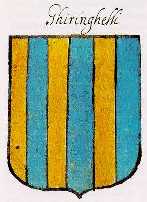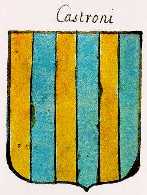
Ghiringhelli
Nearly all early family names are derived from the place of origin of the family.
Ghiringhelli is one of the few exceptions to this general rule. But what makes it even more unusual is that the village of Caronno Ghiringhello in Lombardy, Italy, got its name from the Ghiringhelli.
The family name appears in documents from the 11th century onwards, showing the Ghiringhelli in roles of great prestige, whether political or social. Here are but a few:
The name is first documented in a deed of sale drawn up in Milan in January 1097 citing de Gilingelli 1 as possessing land in loco et fundo Vicomaiore (the parish of Vimaggiore in Decimo). The Ghiringhelli are well attested in Milan in the 13th century. The city archives record that Salvagius Ghiringhellus was sent by the podestÓ2 of Vercelli as miles et ambaxador (soldier and representative) to clarify the holdings of the Marquis of Monferrato. And in 1259, the podestÓ Baldo Ghiringhelli tried unsuccessfully with a few soldiers to oppose Martino della Torre, who took over the city.
Again in the 13th century, a branch of the family is consistently present at Vimodron. In two deeds, one dated 22 October 1264 the other 29 November 1267, both relating to litigation between private landowners and the Monastery of Chiarevalle, about a dozen individual owners with the surname Ghiringhelli are cited as owning land in the locality. Foremost amongst these is Galvaneus Ghiringhelli who, judging by the parchment document of 1267, in addition to having the noble appellation of dominus3, is shown as the major landowner in the area.
Moving on to the second half of the 14th century, in 1388 amongst the citizens of Milan who are members of the Consiglio dei 900 from Porta Orientalis in the parish of St. Paul in Campedo there are two domini, both called Ambrogio Ghiringhelli and a further dominus called Maffiolo Ghiringhelli; and at Porta Nuova in the parish of San Stefano ad Nuxigiam the dominus Antonio Ghiringhelli. And from a list, dated 1408, of the nobiles familiares et officialles of the ducal court of Milan, the dominus Umberto Ghiringhelli.
In the second half of the 15th century quite a number of Ghiringhelli hold prominent positions in Milan. Gabriele Ghiringhelli and his son Andrea are both recorded as Civil Engineers of the Commune of Milan; Bernardino Ghiringhelli, son of Andrea, Surveyor of Roads of Milan. Another Bernardino Ghiringhelli appears amongst i notari sindicorum Mediolani (Milanese Syndicate of Public Notaries). A Gabriele Ghiringhelli and his son Bernardino, both ducal engineers. A Bernardino Ghiringhelli 'de Intra' (from Intra, Lake Maggiore) was the Official in Charge of bridges, ports, and roads of Lake Maggiore. A Giorgio Ghiringhelli, podestÓ of Vespolate; a Tadeo Ghiringhelli, a referendary4 of Cremona, and lastly Umberto Ghiringhelli who had a very successful administrative career, from Assistant Chancellor of Common Revenues, then, via higher civic posts, ending as Chancellor del capitanato della caccia5.
In the 16th century, Ghiringhelli's continued to hold important posts in Milan, amongst these, cavaliero or cavaglier Ghiringhello who, during the plague of 1576/1577 was Surveyor of Roads and listed in the sixty members of the City General Council.
The above information is taken from a book titled Caronno Varesino (giÓ Ghiringhello) tra cronaca e storia by Diego Dalla Gasparina and Carlo Mastorgio, published by the Municipality of Caronno Varesino.
Bellinzona
They continue
But staying only in Milan we could continue endlessly as would be the case were we to talk of other Ghiringhelli which we find already scattered in earlier ages in various cities outside of Italy, like that branch of the Ghiringhelli family which settled in Bellinzona in the 15th century and which flourished there, with many eminent persons.
My own researches show, however, that the Bellinzona branch of Ghiringhelli were settled in that city whilst it was still part of the Duchy of Milan, hence part of Italy. The Bellinzona archives have a record of donations being made to the Archpriest Ghiringhelli of Bellinzona (circa 1390 - 1464) pastorae d'anime (shepperd of souls).
Bellinzona was ceded to Switzerland, being part of Ticino, at the peace settlement imposed by France following the definitive defeat of the Swiss at the battle of Marignano, near Milan, in 1515. In return, the Swiss finally renounced their ambitions to conquer Lombardy. After some uncertainty Mendrisio also passed to Switzerland in 1522. During these turbulent times the highest Swiss authority in Mendrisio in the baliaggio6 was the Landfogto who remained in post for two years; the Landfogto were often violent and tyrannical and a few were assassinated by the enraged populace. The Landfogto was assisted by two officials, the Luogotenente (here meaning Deputy, rather than lieutenant) and the Landscriba (Chancellor). The post of Luogotenente was often filled by members of powerful noble families, such as the Torriani, Rusca, and the Ghiringhelli whilst the post of Landscriba was monopolized by the Beroldingen, fitted for the post because they spoke German. The source for this is at the official Municipal Mendrisio site History of Mendrisio.
Following this violent century, the Ghiringhelli of Bellinzona frequently appear as prominent churchmen. Indeed in honour of an eminent 18th century cleric one of the principal streets in Bellinzona is the Via Canonico Ghiringhelli.
Today members of the Swiss branch of Ghiringhelli appear to be lawyers and financiers, perhaps the best known internationally being Giorgio Ghiringhelli, President of the Banca della Svizzera Italiana, the prestigious Swiss-Italian Bank.
Caronno Ghiringhello
Caronno Ghiringhello, now called Caronno Varesino, is a small Lombard town to the south of Varese. The name was stupidly changed in 1940 by the Fascist regime, along with the names of many other ancient places, to make them sound more Roman and Latin. Ghiringhello's unpardonable sin being that legend has it that he was a Bavarian soldier, a vassal of the Emperor Frederick Barbarossa. Unfortunately none of the original place names has been restored so far.
Leaving legend aside and turning to Caronno Varesino (giÓ Ghiringhello) tra cronaca e storia by Gasparina and Mastorgio:
What we would like to know is the precise relationship that the Ghiringhelli had with the territory of Caronno in the medieval age. Were they vassals or vavasours7. In the present state of our knowledge, lacking any documentary evidence, it is impossible to answer this question.Nonetheless they were certainly noble and their status dated back to the hierarchical vassalages of the Milanese-Sepriese feudal structure of the 10th and 11th centuries.
To date, the oldest document we possess in which there appears the name of a member of the Ghiringhelli family tied to our town is dated 11 December 1177. It is a deed of sale of a parcel of land located in Assanio, near Milan, by a certain Guazinus Callosus, husband of Flos, to Arderico Romodii; On the deed their is il Signum + manum Iohannisbelli Giringelli et Lavizioli de Caronno propinqui suprascripte Floris qui cam interrogaverunt ut supra et ad confirmandum manus posuerunt. [the signed mark of Iohannisbelli Giringelli and Lavizioli of Caronno near the above written Flos, who questioned her as above and in confirmation of this have given their hand.]
About fifty years later, in 1225, there is firm evidence that members of the Ghiringhelli family lived in Caronno with the additional important information that they are domini. It concerns the bestowal of feudal rights to furnishings in favour of dominus Ardicius. What is pertinent here is that present amongst the witnesses is dominus Jacobus filius quondam dominii Bruni Girengelli de loco Carronno. [Lord Giacobo son of the late Lord Bruno Ghiringhelli of Caronno.]
They quote another document of 1273 in which the then village is referred to as Carono de Giringelis and cite further evidence that the town got its name from the Ghiringhelli and not the other way round.
To continue
Moreover in the Matricola Nobilum of 1377 two lines of the family are listed Gheringhellis de Carono and Ghiringhellis de Mediolano [Milan]. From further documents of the late medieval period there is ample proof and important confirmation that the family was well rooted and established in our territory and which testify that they were in possession of considerable wealth and power in the band of territory which, in addition to Caronno, includes Castronno, Valdarno, and Gazzada.


In an early heraldic manuscript housed in the Trivulziana8 , the arms9 of the Ghiringhelli and the arms of the de Castrono branch, reproduced here, are identical.
The family, according to Gasparina and Mastorgio, was "decidedly the most important one in Castronno. " In 1566 the parish priest of Castronno is Father Ludovico Ghiringhelli; and in 1632 a Francesco Ghiringhelli is recorded as "Laudable for having rebuilt the church of Sts Nazario and Celso at his own expense." ;and numerous are the Ghiringhelli who left legacies to the church.
The church of St Rocco in Castronno seems to have been built by the Ghiringhelli for their private devotion, this has come to light through recent restoration work which has revealed frescoes which appear to form a unified theme, the inscription revealed at the side of a "Holy Bishop" bears the name of the purchaser and the date 1527, Hoc opus fecit fieri Margherita Ghiringhelli.
Valdarno
Here too the Ghiringhelli had considerable influence. In 1392, in fact, Giacomo and Paolo Ghiringhelli as executors of Giovanni Ghiringhelli, founded the Chaplancy of Santa Maria di Valdarno. Initially it had assigned to it only the legacy of Giovanni, a vineyard called Vignazza at Caronno Ghiringhello, but in the course of time this was greatly augmented. Following from Ambrogio and Giacomo Ghiringhelli the ius patronatus10, the right to nominate the chaplains, together with the right to be buried in the church, was hereditary in the male line. This lasted down to 1751 when Pietro Francesco Ghiringhelli donated the ius patronatus to the Visconti brothers, whose line ended with Federico Visconti, Archbishop of Milan.
Another consistent group of families of the Ghiringhelli are found in nearby Gazzada where they had the ius patronatus of the church of Santa Maria Assunta. This little church was built through the will of Antoniotto Ghiringhelli. In his will, probated on 18 March 1488, he ordered that a chapel should be erected for which he left 125 florins, additionally he bestowed sufficient property on the church to enable a priest to celebrate Mass there three times a week, including Sundays, in perpetuity, for the benefit of the villagers to save them the discomfort of having to go to Schiano. The property he left for this purpose consisted of rental income in perpetuity and scattered small parcels of land in the territories of Travano, Castronno, Albizzate, Sumirago, and Caidate.
He assigned the ius patronatus to the descendents of his brother Giovanni and to Fillipo and Bernardo, sons of his other brother Luigi, leaving the preference to the eldest. In the case of failure of their line, he willed that the ius patronatus was to go to the descendants of Giovanni Ghiringhelli of Bellinzona and to the three brothers Giovanni, Antonio, and Pedrono Ghiringhelli of Brissago.
Amongst the decrees of Archbishop Cardinal Carlo Borromeo, who visited Gazzada on 27 June 1574, there is an order to the parish priest to re-implement the legacy bequeathed by Antonio Ghiringhelli in which he willed that annually, on the eve of the feast of St. Anthony (his patronymic saint), 28 staia11 of millet and rye were to be distributed to the poor.
Peter Ghiringhelli, B.A.(Hons), M.A.
Return to
Top
If you did not arrive at this page from my Home Page you may access it here.

de Gilingelli 1097
Giringelli 1177
Girengelli 1225
Ghiringhellus 13th century, a Latinised form
Ghiringhellis 1377
Ghiringhelli 14th century
Note that Ghiringhello is the singular of the plural Ghiringhelli (the Italian custom in surnames is to name the 'house', i.e., Joseph Greens rather than the singular Joseph Green Giuseppe Verdi.
return